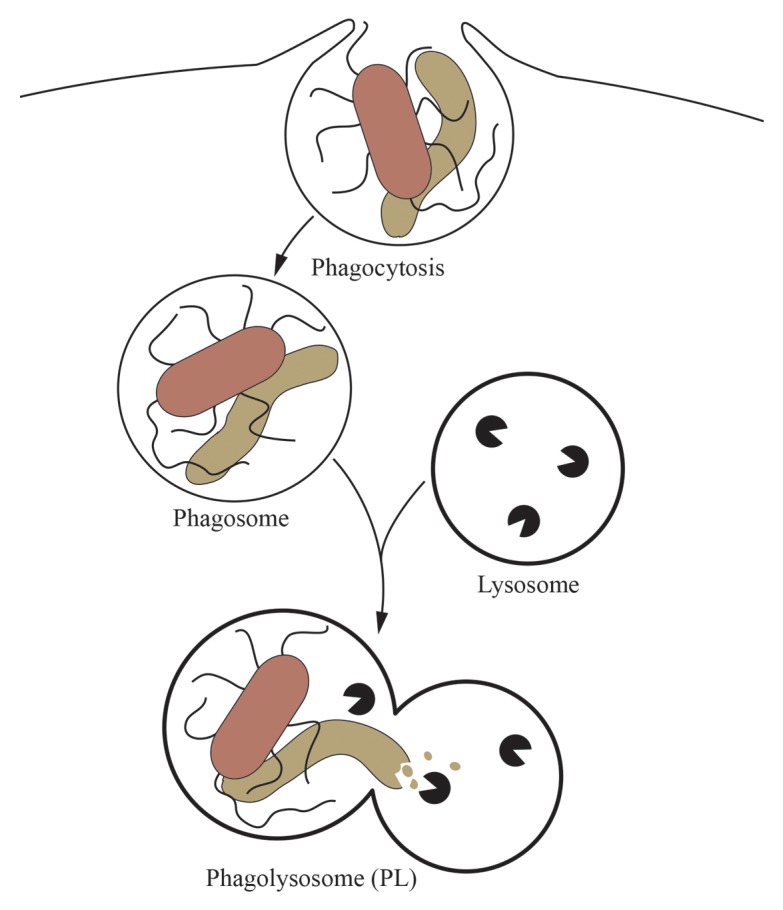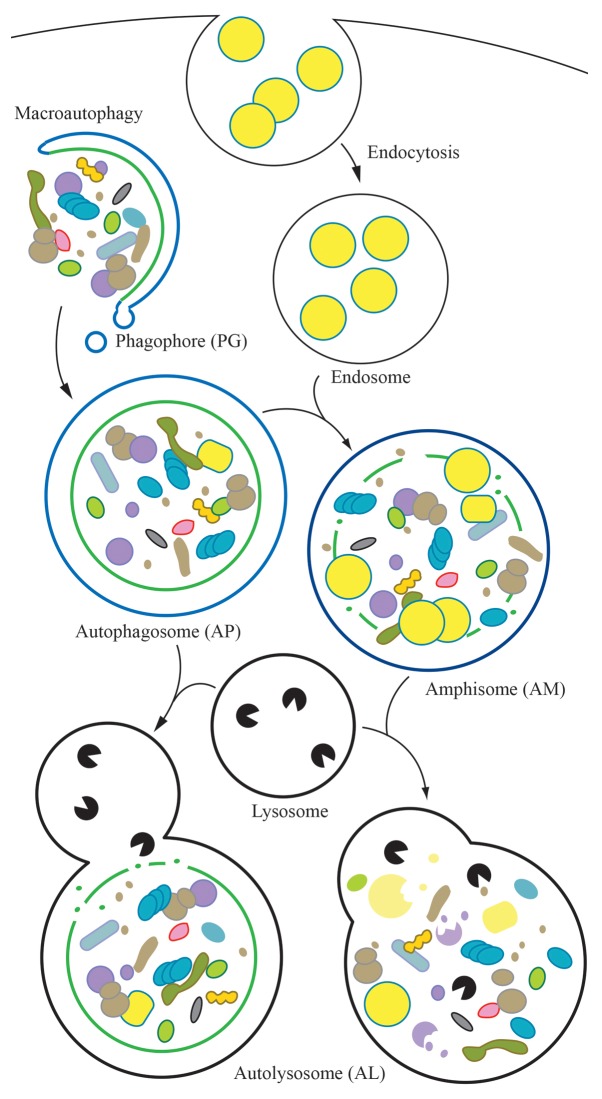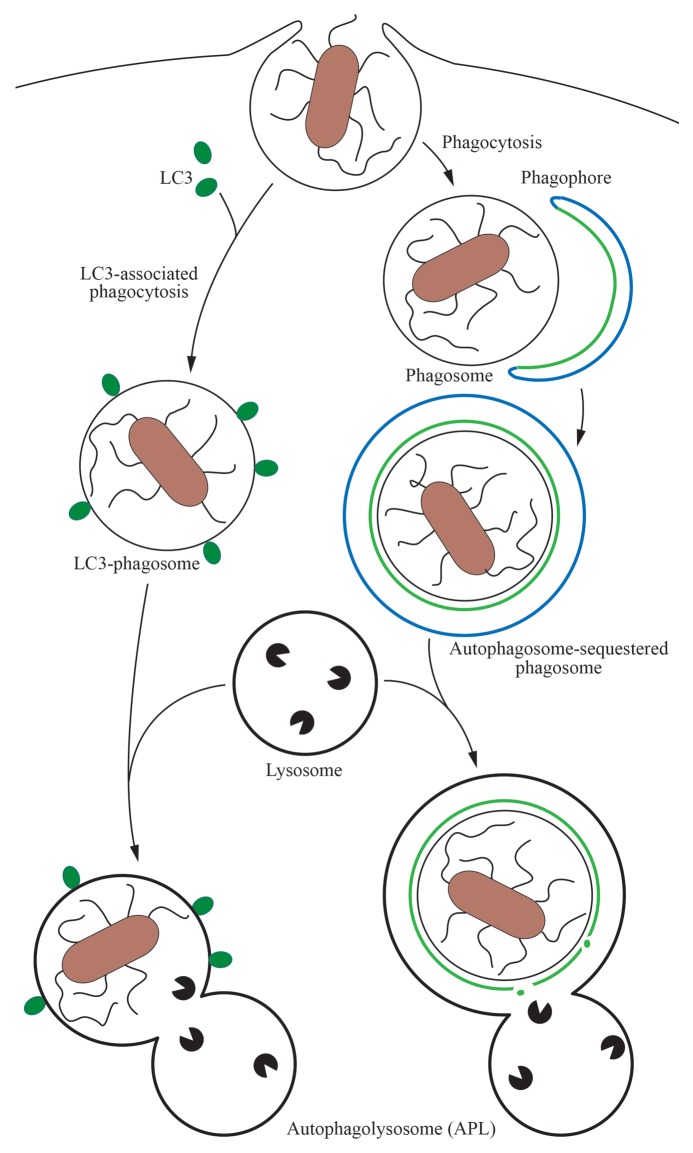Abstract
When an autophagosome or an amphisome fuse with a lysosome, the resulting compartment is referred to as an autolysosome. Some people writing papers on the topic of autophagy use the terms “autolysosome” and “autophagolysosome” interchangeably. We contend that these words should be used to denote 2 different compartments, and that it is worthwhile maintaining this distinction—the autophagolysosome has a particular origin in the process of xenophagy that makes it distinct from an autolysosome.
Keywords: amphisome, lysosome, phagophore, stress, xenophagy
Various terms are used to differentiate among the compartments in a eukaryotic cell, and there is a reason for having specific names—this allows scientists to communicate with each other in a clear manner. For example, the direct fusion of an autophagosome with a lysosome produces an autolysosome (Fig. 1), which is a term that most researchers in the autophagy field agree upon.1 One potential source of confusion regarding nomenclature is due to the convergence of macroautophagy with endocytosis and phagocytosis. When an endosome (a single-membrane compartment) fuses with an autophagosome, the product is an amphisome,2 which is also a single-membrane compartment (where the inner autophagosome membrane begins to be degraded; Fig. 1). The subsequent fusion of an amphisome with a lysosome generates an autolysosome, and the use of the term autolysosome in this circumstance is again generally accepted. During phagocytosis, a single-membrane phagosome is generated, and this compartment may fuse directly with a lysosome to produce a phagolysosome (Fig. 2).3 Again, there is generally good agreement on the use of this term to denote the fusion product. We emphasize for clarity that this is the product of conventional phagosome and lysosome fusion in the absence of autophagy.
Figure 1. The autolysosome. The fusion of a double-membrane autophagosome (AP) with a lysosome generates an autolysosome (AL). Similarly, the convergence of macroautophagy and endocytosis produces a single-membrane amphisome (AM) that also results in an autolysosome upon fusion with a lysosome. PG, phagophore.

Figure 2. The phagolysosome. A single-membrane phagosome can fuse directly with a lysosome, independent of the autophagic machinery. The resulting compartment is a phagolysosome (PL). Note that a phagosome can also fuse with an endosome prior to fusion with a lysosome (not depicted).
One example of particular interest to the autophagy field is the fusion of an LC3-decorated phagosome with a lysosome, as occurs during LC3-associated phagocytosis.4 In this case, the fusion product is termed an autophagolysosome (Fig. 3). It is important to be able to refer to this distinct term because some microbes, such as Mycobacterium tuberculosis, survive inside their hosts by inhibiting the fusion of the phagosome with the lysosome, thus preventing formation of a conventional phagolysosome.3,5 There is also the possibility, that the phagosome becomes sequestered within an autophagosome.6 In this case, when the autophagosome fuses with a lysosome the resulting compartment is again termed an autophagolysosome (Fig. 3). Thus, the autophagolysosome denotes a very specific situation that occurs during some types of xenophagy; in particular when the process involves a phagosome and components of the autophagic machinery. Accordingly, we stress the importance of maintaining the distinction between the terms autolysosome, phagolysosome, and autophagolysosome.
Figure 3. The autophagolysosome. There are several types of xenophagy, the selective sequestration and degradation of invasive microbes by macroautophagy. When an LC3-decorated phagosome, or an autophagosome that has sequestered a phagosome, fuse with a lysosome, the product is an autophagolysosome (APL). For simplicity, LC3 is not shown on the phagophore or autophagosome.
Disclosure of Potential Conflicts of Interest
No potential conflicts of interest were disclosed.
Acknowlwdgements
This work was supported by NIH grant GM053396 (to DJK), Academy of Finland, Biocentrum Helsinki and Sigrid Juselius grants (to E-LE), and NIH grants AI042999 and AI111935 (to VD).
References
- 1.Ericsson JL. Studies on induced cellular autophagy. I. Electron microscopy of cells with in vivo labelled lysosomes. Exp Cell Res. 1969;55:95–106. doi: 10.1016/0014-4827(69)90462-5. [DOI] [PubMed] [Google Scholar]
- 2.Gordon PB, Seglen PO. Prelysosomal convergence of autophagic and endocytic pathways. Biochem Biophys Res Commun. 1988;151:40–7. doi: 10.1016/0006-291X(88)90556-6. [DOI] [PubMed] [Google Scholar]
- 3.Armstrong JA, Hart PD. Response of cultured macrophages to Mycobacterium tuberculosis, with observations on fusion of lysosomes with phagosomes. J Exp Med. 1971;134:713–40. doi: 10.1084/jem.134.3.713. [DOI] [PMC free article] [PubMed] [Google Scholar]
- 4.Martinez J, Almendinger J, Oberst A, Ness R, Dillon CP, Fitzgerald P, Hengartner MO, Green DR. Microtubule-associated protein 1 light chain 3 alpha (LC3)-associated phagocytosis is required for the efficient clearance of dead cells. Proc Natl Acad Sci U S A. 2011;108:17396–401. doi: 10.1073/pnas.1113421108. [DOI] [PMC free article] [PubMed] [Google Scholar] [Retracted]
- 5.Deretic V, Saitoh T, Akira S. Autophagy in infection, inflammation and immunity. Nat Rev Immunol. 2013;13:722–37. doi: 10.1038/nri3532. [DOI] [PMC free article] [PubMed] [Google Scholar]
- 6.Amer AO, Swanson MS. Autophagy is an immediate macrophage response to Legionella pneumophila. Cell Microbiol. 2005;7:765–78. doi: 10.1111/j.1462-5822.2005.00509.x. [DOI] [PMC free article] [PubMed] [Google Scholar]




